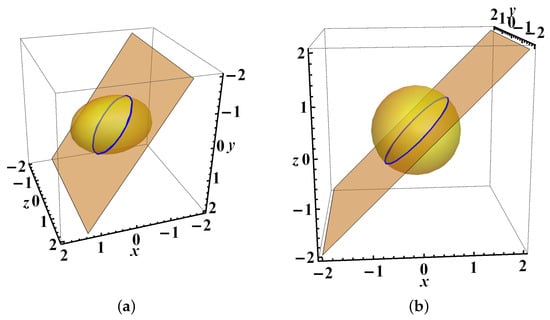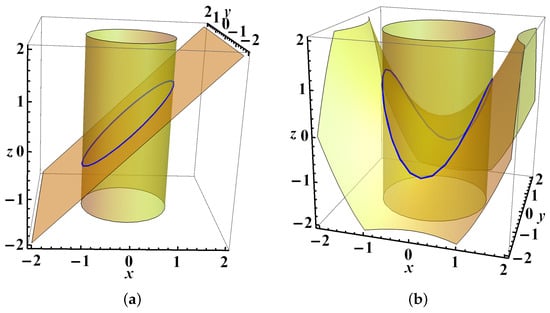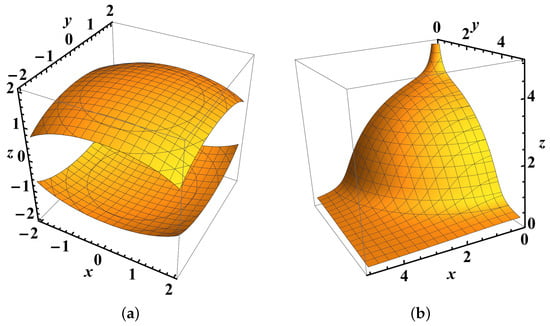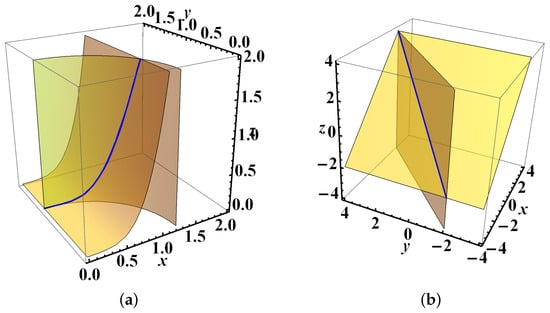Abstract
We study the motion of a test particle in a conservative force-field. Our aim is to find three-dimensional potentials with symmetrical properties, i.e., , or, and , where P and Q are arbitrary -functions, which are characterized as semi-separable and they produce a pre-assigned two-parametric family of orbits = , = (, = const) in 3D space. There exist two linear PDEs which are the basic equations of the Inverse Problem of Newtonian Dynamics and are satisfied by these potentials. Pertinent examples are presented for all the cases. Two-dimensional potentials are also included into our study. Families of straight lines is a special category of curves in 3D space and are examined separately.
1. Introduction
A dynamical system is a system whose state evolves with time over a state space according to a fixed rule. Examples of dynamical systems are the following ones: the growth of a population, a swinging pendulum, the motions of celestial bodies and so on. Mathematical methods for mechanical, electrical and biosystems were developed in [1]. Integrability [2], superintegrability [3], or, non-integrability [4] are some special properties of dynamical systems.
The inverse problem of dynamics, as formulated by [5], consists in looking for all potentials which can produce a monoparametric family of planar orbits , traced in the -Cartesian plane by a material point of unit mass with a preassigned energy dependence on the given family of orbits. The author produced a first-order partial differential equation, linear in the unknown function whose coefficients depend on the family of orbits. Szebehely’s equation was later studied by many authors [6,7,8].
The three-dimensional inverse problem of dynamics, as described by [9], deals with the potentials of -class which produce a pre-assigned family of regular orbits given with a preasgned energy dependence on the given families of orbits. Before many years, several authors paid attention to this problem and studied different versions of it (see [10,11,12]). Especially, two-parametric families of straight lines (FSL) produced by three-dimensional potentials were studied in detail by [13]. The two free of energy PDEs of the three-dimensional inverse problem were found in [14,15]. Besides that, in [15], the authors constructed 3D homogeneous potentials of degree m producing homogeneous two-parametric families of orbits in 3D space and presented many examples. Other solvable cases of this problem were examined in [16,17]. In [18], the authors stated and solved a generalization of Dainelli and Joukovski problem and proposed a new method in order to solve the well-known Suslov’s problem. Inverse problems exist in many areas of Physics. More precisely, inverse problems for Schrödinger equation were studied by many authors in the past (e.g., [19]). An application of the inverse problem of dynamics in geometrical optics was given by [20]. Furthermore, ref. [21] approached the problem from the point of view of the general inverse problem of the calculus of variation. In [22] the authors presnted a direct method for solving inverse Sturm–Liouville problems Recently, integrable and superintegrable 3D Newtonian potentials were studied in [23] by using quadratic first integrals.
In this work we shall examine three-dimensional potentials of the form , and which are related to a two-parametric family of orbits = , = (). These potentials are common solutions of two linear PDEs which govern the Inverse Problem of dynamics; one of them is of first order and the second one is of second order.
The present paper has the following structure: In Section 2 we give the basic facts of the 3D Inverse Problem of Dynamics and we present the basic equations of this problem. Separable potentials have the general form , or, . Since the number of equations of the Inverse problem is two, i.e., Equations (9) and (11) in the text, and the functions are three, we choose semi-separable potentials of the form , and in order to handle the two equations of the Inverse problem. Thus, we start our survey with potentials and we develop a new methodology for this kind of potentials in Section 3. The second order PDE of the inverse problem becomes a linear second order PDE in the unknown function and can be solved analytically under ceratin conditions. In Section 4 we work with potentials . From the second order PDE we retrieve two linear O.D.Es in the unknown functions respectively which are solvable. This technique help us to find the general solution for the potential V. Our results are connected with integrability/superintegrability of potentials which are under consideration.
In Section 5 we study the third class of potentials . This class is more complicated than the previous ones. Now, the second order PDE becomes a non-linear PDE in the unknown function and cannot be solved analytically by using the classical methods of the theory of PDEs. Thus, we look only for special solutions. We offer examples for all cases. The results are new and original. Special cases are studied in Section 6. Another category of potentials is the two-dimensional ones (Section 7). Two-parametric families of orbits produced by two-dimensional potentials were examined in [24]. Furthermore, an interesting case of curves in 3D space is a family of straight lines. As it was shown by [13], not any potentials, but only those satisfying two non-linear PDEs can produce a family of straight lines as orbits. We find appropriate potentials which correspond to the above cases in Section 8 and we are making some concluding comments in Section 9.
2. The Formulation of the 3D Inverse Problem
We consider the two-parametric family of orbits given
Generally speaking, the two–parametric families of orbits written in the form (1) are studied in a three-dimensional frame. The most general question in Classical Mechanics is to find a potential function such that the set of integral curves of the classical mechanical system
contains the given family (1). Following [14,15,24], we define the vector = which is proportional to the velocity. Its components are
As it was shown by [14,15,24], the family of orbits (1) can be represented by two “slope functions”
given by the formulas
On the other hand, if the pair of slope functions () is given in advance, then we can solve analytically the system of O.D.Es
and find the two-parametric family of orbits in the form (1). The following notation is also introduced
and the subscripts denote partial derivatives w.r.t. the variables . There are two basic equations for our problem (see e.g., [15], p. 346). Taking into account that 0, or, 0, these equations read
The above Equation (8) include the energy-dependence . Proceeding more, ref. [15] eliminated the energy of the family of orbits from these two equations and obtained two new equations which include only the derivatives of the potential V and the set of slope functions . These equations are the following ones
where
and
where
It is remarkable to say that if , then we shall make use of another second-order PDE given in the paper of ([17], p. 9226). This PDE reads
where
and
The energy of family of orbits (1) is found to be [15]:
and the kinetic energy of the test particle is
3. The Methodology for Our Problem
In this section we are interested in potentials of the form
which are common solutions of the above two Equations (9) and (11) and are arbitrary -functions of their arguments. First of all, we find the first order derivatives of the potential function V with respect to respectively, i.e., , , , where = . We insert them into (9) and get
Setting , we find the expression for . It is:
where .
Now, we will work with the PDE (11). We obtain the derivatives of second order of the potential function V with respect to and we insert them into Equation (11). Thus, we get the linear second-order PDE
If we insert (20) into (21), then the PDE (21) reads
where and . Since the unknown function in (22) depends only on two variables , the corresponding coefficients must have the same property. Now, we can formulate the next
Theorem 2.
Results
In this Section we present the first example.
Example 1.
We study the two-parametric family of orbits (see Figure 1a)
which is represented by the pair
After some simplifications, the coefficients in (22) take the form
According to the Theorem 2, the coefficients (26) satisfy the condition (23). Then, the PDE (22) reads
The discriminant of the characteristic equation of the PDE (27) is
So, the PDE (27) is hyperbolic and the characteristic roots are
Proceeding more, we solve the system
and we find the characteristic curves
where const. We make the transformation
and we estimate the first and second-order derivatives of the function P with respect to the new variables . After some straightforward algebra, the PDE (27) reads
or, equivalently,
The general solution of (34) is
where are arbitrary functions of their unique arguments respectively. We turn back to the old variables and the general solution (35) is written as
Finally, we have to determine the function . We insert (36) into (20) and we check the following conditions
The conditions (37) are satisfied if and only if
or, equivalently,
By using the relations (36) and (39), we find
From (20), we have
and the result is
With the aid of (40) and (42), we obtain the potential
which is integrable.
4. Potentials of the Form
In this paragraph we shall deal with Equations (9) and (13) and study the second class of potentials
where and are arbitrary functions of their arguments u and z respectively. At the first step, we find the derivatives: , , , where = and =. We insert them into (9) and obtain
If 0, then we proceed as follows. From (45) we get
Since , it must be . Thus, we have
From (47) we find the functions and . It is:
Next we proceed with the second order derivatives of the potential function (44) with respect to and we insert them into Equation (13). After that, we get the following expression
where
Theorem 3.
Consequently, the Equation (49) can be rewritten in a more concise form:
Thus, we have to solve two independent O.D.E.s namely
and
The additon of these two solutions provides us with the result .
Remark 2.
If 0, then we check the expression of . We distinguish two cases:
- 0. Then, the relation (45) is satisfied identically.
- 0. Then we have 0. This result leads to which is excluded from our study.
Results for the Second Case
In this paragraph we shall preseng two examples for this case.
Example 2.
We consider the family of orbits (see Figure 1b)
which is related to the pair
We will find a potential of the form (44) which produces the above family of orbits. For the given family of orbits (55), we have 0 and
From (48) we find the functions and . It is:
and we replace them into (49). The last equation is satisfied only for = 1. Thus, we obtain
A 3D contour plot of the potential (59) is shown at Figure 2a.
Example 3.



The following family of orbits is considered (see Figure 3a)
The corresponding pair of slope functions is
In this case we have . But we can apply our theory because we deal with Equations (9) and (13). We shall find a potential of the form (44) which creates the above family of orbits. For the given family of orbits (55), we have
Thus, the relation (45) is satisfied identically. Now, we proceed with the Equations (53) and (54). After some simplifications the coefficients in (52) take the form
and we solve analytically O.D.Es. (53) and (54). The solution of the O.D.E. (53) is
or, equivalently,
and the solution of O.D.E. (54) is
Thus, we obatin the result
A 3D contour plot of the potential (67) is shown at Figure 2b. The energy of family of orbits (60) is given by
The potential (67) is separable in cylindrical coordinates. Indeed, if we set , then we get
Without loss of generality, we can omit the other additive constants in (67), or, in (69). As it was shown by ([3], p. 5669), the potential in (67) is minimally superintegrable because it admits four globally defined and single-valued integrals of motion. Other families of orbits generated by this potential are given at Table 1. Additional results are presented at Table 2.


Table 1.
Families of orbits generated by the potential (67).

Table 2.
Families of orbits compatible with 3D potentials.
5. The Third Case:
In this paragraph we shall examine potentials of the form
for the above two Equations (9) and (11), where and are arbitrary functions of their arguments. At the beginning, we determine the derivatives: , , , where = . We insert them into (9) and get
Putting , we find the expression for the ratio . It is:
where . Now, we concentrate on the second order PDE (11). We obtain the second order derivatives of the potential function V and we insert them into Equation (11). Then, we get the second-order PDE
If we replace (72) into (73), then the non-linear PDE (73) reads
Example 4.
We take into account the family of orbits (circles, see Figure 3b)
and the pair is
After some simplifications, the coefficients in (74) take the form
Since the PDE (74) is nonlinear, we find special solutions of the form
We replace (77) into (74), we take
where = . The general solution of (78) is
or, equivalently,
Finally, we have to determine the ratio . We insert (80) into (72) and we check the following conditions
The conditions (81) are satisfied if and only if
Thus, we have
and the result is
With the aid of (77), (80) and (84), we find the potential
6. Special Cases
Up to now we considered that 0 ( is defined in (10)). In this paragraph we shall examine the case = 0. This leads to the result = 0. Thus, we have to use the Equations (9) and (13). We choose potentials of the form
and we calculate the derivatives , , , where =. Then the PDE (6) reads
Now, we shall make use of the second order PDE (13). Working in a similar way as previously, we obtain the second order derivatives of the potential function V and we insert them into Equation (13). Thus, we get the second-order PDE
in which two independent functions, and , are involved. So, in this case, we have to find special solutions for the functions P and Q.
Example 5.
We study the two-parametric family of orbits (circles)
and the corresponding pair of slope functions is
For this set of orbits, we have 0 which leads to 0. After some simplifications, the Equation (87) takes the form
and has the general solution
where M is an arbitrary function of its argument . Then we determine the coefficients in (88). They are
Among others, for the functions P and Q we select
Under these circumstances, the relation (88) is satisfied if and only if
Thus, the potential function is found to be
or, equivalently,
7. Two-Dimensional Potentials
Two-dimensional potentials is another category of potentials and we obtain them if we set 0 in (18), or, if we set 1 in (33). In this case we have to face the problem from the beginning. More precisely, for the given family of orbits (1), we solve analytically the PDE (19) and we find the general solution . Then we insert it in (21) and we check if it is satisfied. We shall offer the following
Example 6.
We deal with the family of orbits (see Figure 4a)
and
The PDE (19) takes the form
The subsidiary system of (99) is
The first independent integral of (100) is:
and the second one will be found if we solve the ODE
By making the transformation , the O.D.E. (101) reads
and the general solution of (102) is
or, equivalently,
The general solution of (99) is = 0, from which we take
where M is an arbitrary function of its unique argument. Now, we insert (105) into (11) and we ascertain that the Equation (11) is satisfied if and only if
which leads to the conclusion that = , (). Thus, the two-dimensional potential is
Remark 3.
8. Families of Straight Lines
If = 0 and = 0, then we have a two-parameter family of straight lines (FSL) in 3-D space under consideration. As it was shown by [13], not any potentials can produce two-parametric families of straight lines in 3-D space, but only those satisfying the following two necessary and sufficient differential conditions
If we replace (18) into (108), then we ascertain that the first of Equation (108) is satisfied when
- .
- .
The Case I leads to the result that . But the second of Equation (108) is satisfied only if = and = , where . Thus, the potential is found to be . Working in a similar way for the Case II, we obtain the following result: . For the first result, the family of straight lines is
or, equivalently,
A member of the family of straight lines (110) is shown at Figure 4b. For the second result, the family of straight lines is
or, equivalently,
Another choice is . The first of Equation (108) is satisfied identically but the second one is verified when
which means that , where . Thus, the total expression for the potential is
Similar results were obtained by [13,21].
9. Concluding Comments
In the present paper we studied semi-separable potentials as solutions of the 3D inverse problem of Newtonian dynamics. These potentials are: , or, and and are very useful in physical problems. Our aim was to find two-parametric families of spatial regular orbits = , = , ( = const), which are generated by these potentials.
It is known that the two basic PDEs (9) and (11) combine potentials and families of orbits (Section 3) taking into account that at least one of is different from zero. In the first case the second order PDE (11) is transformed to a linear second order PDE of a function P of two variables, i.e., , and can be solved analytically by using the classical methods of the theory of PDEs. For the second case, we found three-dimensional integrable potentials. In the third case, the second order PDE (11) is transformed to a non-linear second order PDE of a function P of two variables, i.e., , and cannot be solved analytically. Furthermore, special cases of the problem were also studied and useful results were obtained. The problem is more complicated now than the previous ones because we deal with two independent functions and and we have to guess which the appropriate solutions are. Thus, we search special solutions in order to get a potential which generates the given family of orbits (1). Another category is the 2D potentials and were examined separately. Many simplifications can be made in this case because the function has a constant value. Families of straight lines is an interesting case of curves in 3D space and we studied potentials which produce them. Not any potentials but only those which satisfy the differential relations (108) in the text can produce a two-parametric family of straight lines.The examples are new and original and cover all the cases.
Funding
This research received no external funding.
Data Availability Statement
The data that support the findings of this study are available from the corresponding author upon reasonable request.
Acknowledgments
I would like to thank G. Bozis, Department of Physics, for many useful discussions.
Conflicts of Interest
The author declares no conflict of interest.
References
- Luo, A.C.J.; Machado, J.A.T.; Baleanu, D. Dynamical Systems and Methods; Springer: New York, NY, USA, 2012. [Google Scholar]
- Volchenkov, D. Nonlinear Dynamics, Chaos, and Complexity: In Memory of Professor Valentin Afraimovich; Higher Education Press, Springer: Singapore, 2021. [Google Scholar]
- Evans, N.W. Superintegrability in classical mechanics. Phys. Rev. A 1989, 41, 5666–5676. [Google Scholar] [CrossRef]
- Meletlidou, E.; Ichtiaroglou, S. A criterion for non-integrability based on Poincare’s theorem. Physica D 1994, 71, 261–268. [Google Scholar] [CrossRef]
- Szebehely, V. On the determination of the potential by satellite observations. In Proceedings of the International Meeting on Earth’s Rotation by Satellite Observation; Proverbio, G., Ed.; The University of Cagliari Bologna: Bologna, Italy, 1974; pp. 31–35. [Google Scholar]
- Bozis, G. Determination of autonomous three-dimensional force fields from a two-parametric family. Celest. Mech. 1983, 31, 43–51. [Google Scholar] [CrossRef]
- Bozis, G. Szebehely’s inverse problem for finite symmetrical material concentrations. Astron. Astrophys. 1984, 134, 360–364. [Google Scholar]
- Puel, F. Intrinsic formulation of Szebehely’s equation. Celest. Mech. Dyn. Astron. 1984, 32, 209–216. [Google Scholar] [CrossRef]
- Bozis, G.; Nakhla, A. Solution of the three-dimensional inverse problem. Celest. Mech. 1986, 38, 357–375. [Google Scholar] [CrossRef]
- Váradi, F.; Érdi, B. Existence of the solution of Szebehely’s equation in three dimensions using a two-parametric family of orbits. Celest. Mech. 1983, 30, 395–405. [Google Scholar] [CrossRef]
- Shorokhov, S.G. Solution of an inverse problem of the Dynamics of a particle. Celest. Mech. 1988, 44, 193–206. [Google Scholar] [CrossRef]
- Puel, F. Explicit Solutions of the Three Dimensional Inverse Problem of Dynamics Using the Frenet Reference System. Celest. Mech. Dyn. Astron. 1992, 53, 207–218. [Google Scholar] [CrossRef]
- Bozis, G.; Kotoulas, T. Three-dimensional potentials producing families of straight lines (FSL). Rend. Semin. Fac. Sci. Univ. Cagliari 2004, 74, 83–99. [Google Scholar]
- Anisiu, M.-C. The energy-free equations of the 3D inverse problem of dynamics. Inverse Probl. Sci. Eng. 2005, 13, 545–558. [Google Scholar] [CrossRef]
- Bozis, G.; Kotoulas, T. Homogeneous two-parametric families of orbits in three-dimensional homogeneous potentials. Inverse Probl. 2005, 21, 343–356. [Google Scholar] [CrossRef]
- Anisiu, M.-C.; Kotoulas, T. Construction of 3D potentials from a pre-assigned two-parametric family of orbits. Inverse Probl. 2006, 22, 2255–2269. [Google Scholar] [CrossRef]
- Kotoulas, T.; Bozis, G. Two-parametric families of orbits in axisymmetric potentials. J. Phys. A Math. Gen. 2006, 39, 9223–9230. [Google Scholar] [CrossRef]
- Alboul, L.; Mencia, J.; Ramirez, R.; Sadovskaia, N. On the determination of the potential function from given orbits. Czechoslov. Math. J. 2008, 133, 799–821. [Google Scholar] [CrossRef]
- Cardoulis, L.; Cristofol, M.; Gaitan, P. Inverse Problem for the Schrödinger Operator in an Unbounded Strip. J. Phys. Conf. Ser. 2008, 124, 012015. [Google Scholar] [CrossRef]
- Borghero, F.; Demontis, F. Three-dimensional inverse problem of geometrical optics: A mathematical comparison between Fermat’s principle and the eikonal equation. J. Opt. Soc. Am. A 2016, 33, 1710. [Google Scholar] [CrossRef] [PubMed]
- Sarlet, W.; Mestdag, T.; Prince, G. A generalization of Szebehely’s inverse problem of dynamics in dimension three. Rep. Math. Phys. 2017, 79, 367–389. [Google Scholar] [CrossRef][Green Version]
- Kravchenko, V.V.; Torba, S.M. A direct method for solving inverse Sturm–Liouville problems. Inverse Probl. 2021, 37, 015015. [Google Scholar] [CrossRef]
- Mitsopoulos, A.; Tsamparlis, M. Integrable and Superintegrable 3D Newtonian Potentials Using Quadratic First Integrals: A Review. Universe 2023, 9, 22. [Google Scholar] [CrossRef]
- Anisiu, M.-C.; Bozis, G. Two-dimensional potentials which generate spatial families of orbits. Astron. Nachrichten 2009, 330, 411–415. [Google Scholar] [CrossRef]
Disclaimer/Publisher’s Note: The statements, opinions and data contained in all publications are solely those of the individual author(s) and contributor(s) and not of MDPI and/or the editor(s). MDPI and/or the editor(s) disclaim responsibility for any injury to people or property resulting from any ideas, methods, instructions or products referred to in the content. |
© 2024 by the author. Licensee MDPI, Basel, Switzerland. This article is an open access article distributed under the terms and conditions of the Creative Commons Attribution (CC BY) license (https://creativecommons.org/licenses/by/4.0/).


